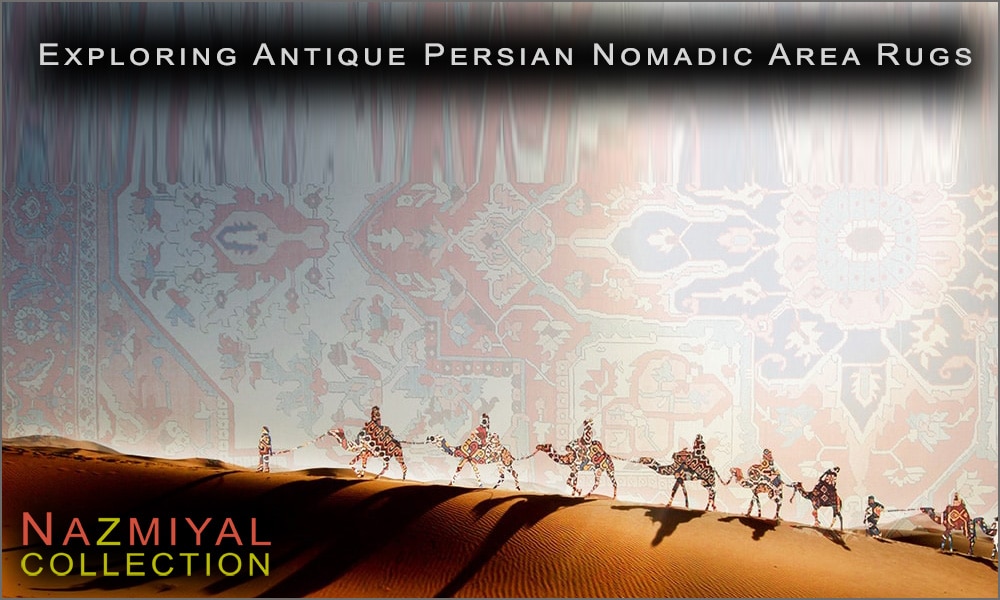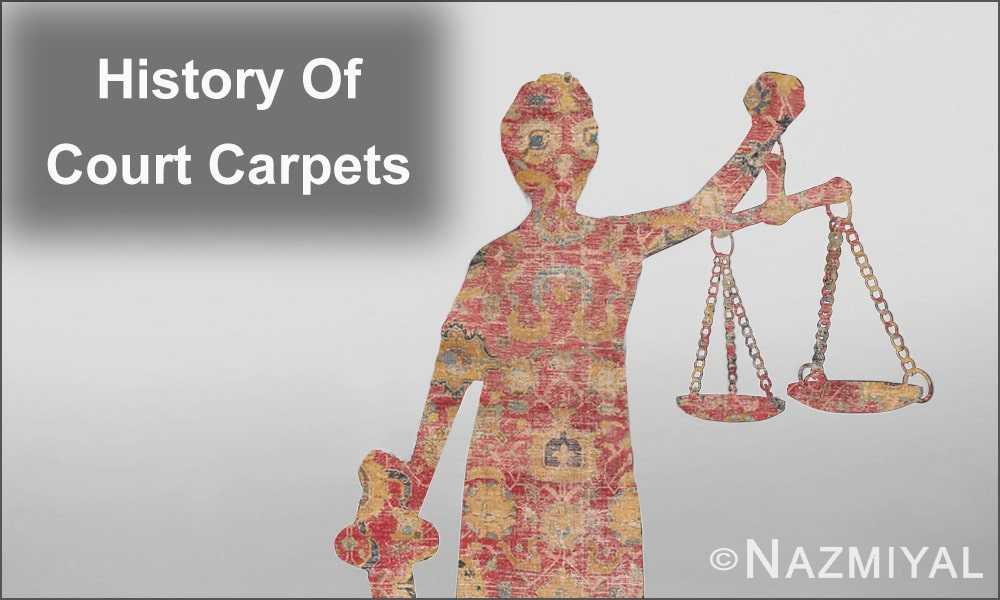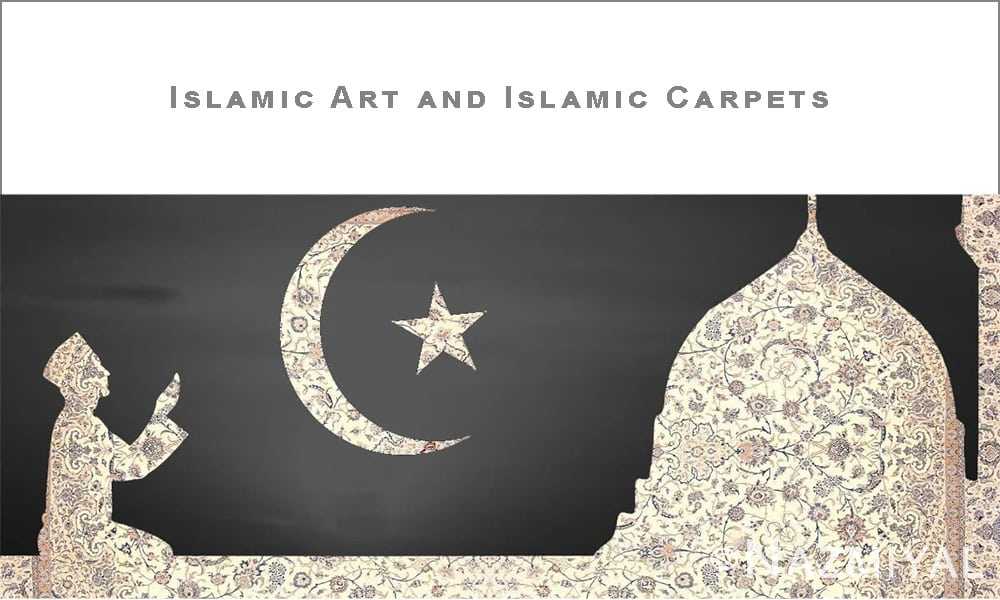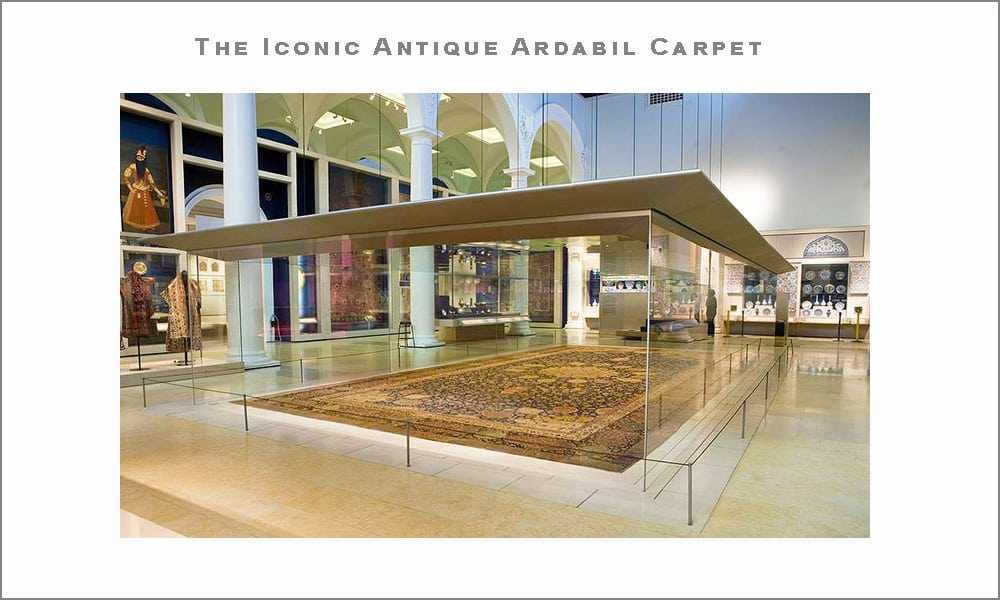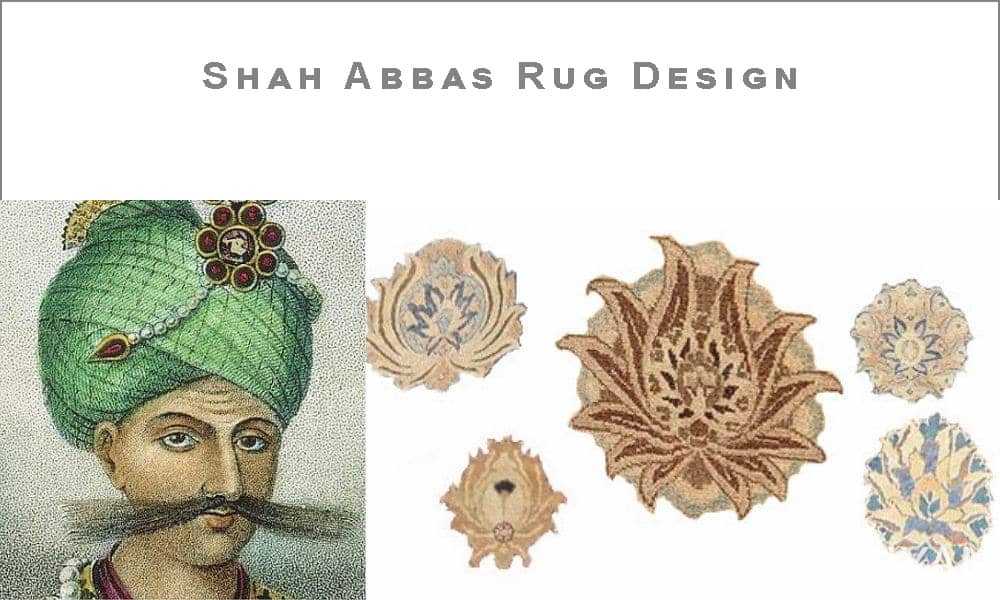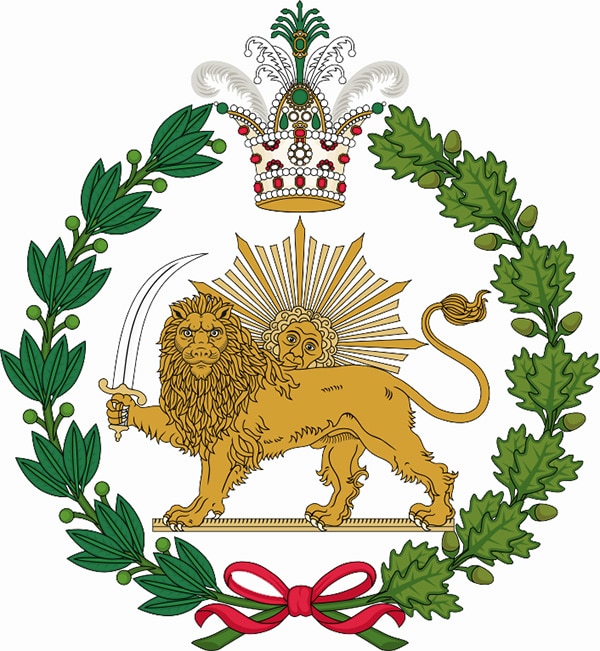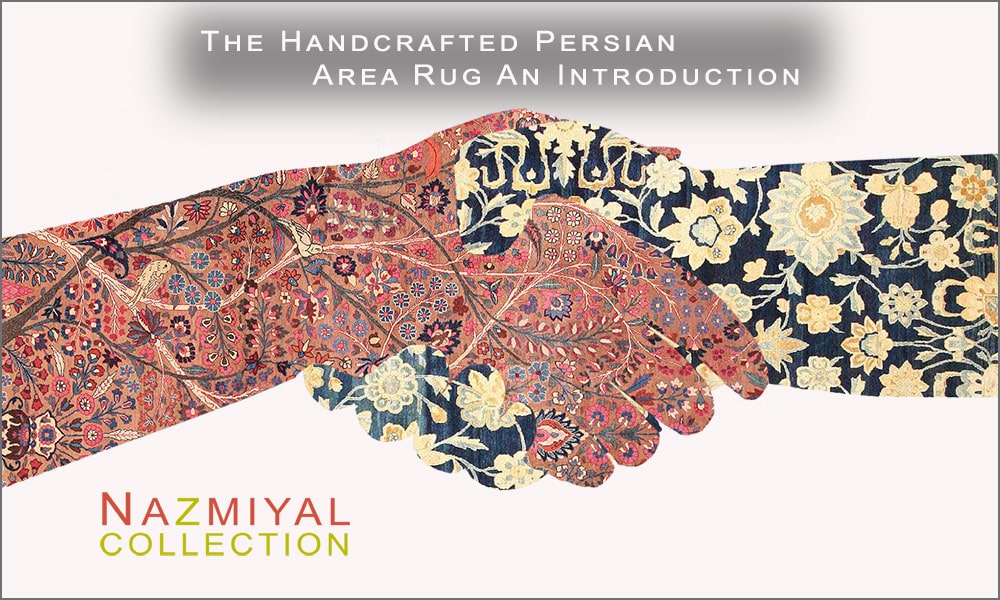History and breakdown of the timeline of Persian rugs
Shop For Persian Rugs | Shop For Antique Rugs | Shop For Vintage Rugs | Shop For Modern Rugs | Create Your Own Unique Persian Influenced Custom Area Rugs
The origins of Persian carpet weaving
The origins of carpet weaving and history of rug making remain obscured, given the natural wear and vulnerability of hand crafted area rugs to wear from use, insects, the elements and material breakdown over time. It is likely that history of Oriental rugs evolved from earlier types of floor coverings, such as felt, or through a method referred to as “flat weaving.”
Creating the flat woven rugs
In flat-woven rugs, the warps and wefts are intricately interwoven to create a flat surface without any pile. This weaving technique further evolved into loop weaving, accomplished by passing the weft strings over a gauge rod, forming loops of thread facing the weaver. The rod can be either removed to leave closed loops or cut over the protecting rod, resulting in a rug resembling a genuine pile rug. Hand-knotted pile rugs, on the other hand, involve individually knotting threads into the warps, with each knot cut after being tied.
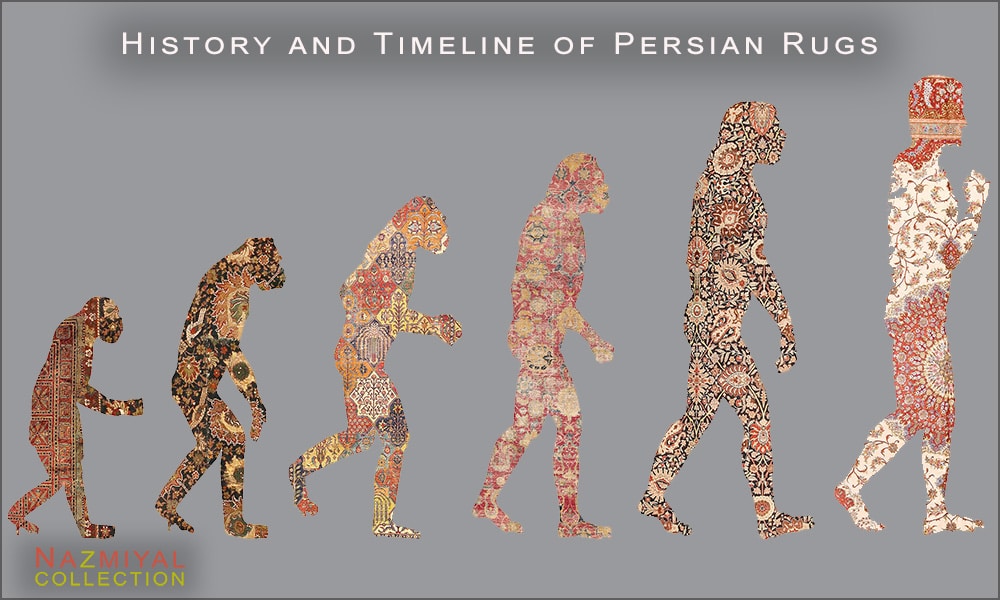
The Complete History and Timeline of Persian Rugs
Learn more: Nomadic origins of Oriental rugs and carpets
The Pazyryk carpet
The Pazyryk carpet, the oldest known pile-woven carpet, was discovered in 1949 within the grave of a Scythian nobleman in Siberia’s Pazyryk Valley, part of the Altai Mountains. Radiocarbon dating indicates its creation in the 5th century BC. This carpet, measuring 183 by 200 centimeters (72 by 79 inches), boasts 36 symmetrical knots per cm2 (232 per inch2). Its intricate craftsmanship reflects a long history of weaving expertise, making it one of the world’s oldest carpets. The central field features a deep red hue, adorned with two animal frieze borders moving in opposite directions, accompanied by guard stripes. The inner main border showcases a procession of deer, while the outer border depicts men on horses and men leading horses, each with diverse saddlecloth designs. Within the inner field, rows of 4×6 identical square frames are set against a red background, each filled with matching star-shaped ornaments formed by overlapping x- and cross-shaped patterns.
Sergei Rudenko, the discoverer of the Pazyryk carpet, originally attributed it to the contemporaneous Achaemenids. However, debate persists regarding whether it was produced in its place of discovery or is a product of Achaemenid craftsmanship. Regardless, its meticulous weaving and intricate design provide a glimpse into the advanced state of carpet weaving during its era.
Ancient Greek documentation mentions the use of carpets, with references found in the writings of Homer around 850 BC, Pliny the Elder’s work mentioning carpets invented in Alexandria, and mentions of carpets in the Odyssey. These early references, however, do not provide technical details about whether these carpets were flatweaves or pile weaves.
Significantly, flat-woven kilims rugs, dating back to at least the fourth or fifth century AD, were uncovered in Turfan, East Turkestan, China, an area still renowned for carpet production. Rug fragments with symmetrical knots, featuring 5-7 interwoven wefts after each row of knots and various color patterns, were also discovered in the Lop Nur region and are now housed at the Victoria and Albert Museum in London. Other fragments, woven with both symmetrical and asymmetrical rug knots, have been unearthed in locations such as Dura-Europos in Syria and the At-Tar caves in Iraq, dating back to the early centuries AD. These findings underscore that the skills and techniques of rug dyeing and carpet weaving were already established in Western Asia before the first century AD.
Early History: Circa 500 BC – 200 AD
Around 400 BC, Persian carpets made their debut in recorded history, courtesy of the Greek author Xenophon’s writings in his book “Anabasis.” In this literary work, Xenophon mentions Persian carpets in a context of opulence and diplomatic significance:
“In his encounter with Timasion the Dardanian, it was rumored that he possessed precious Persian drinking cups and sumptuous carpets.” (Xen. anab. VII.3.18)
“Timasion, in a gesture of goodwill, gifted him a silver bowl and a carpet valued at ten mines.” (Xen. anab. VII.3.27)
Xenophon’s description emphasizes the worthiness of Persian carpets as diplomatic gifts. The exact weaving technique of these area rugs remains a mystery, whether they were pile-woven or crafted using alternative methods like flat-weaving or embroidery / textile. However, it is intriguing that the earliest reference to Persian carpets in world literature immediately associates them with luxury, prestige and diplomacy.
Regrettably, no Persian carpets have survived from the reigns of the Achaemenian (553–330 BC), Seleucid (312–129 BC) and Parthian (ca. 170 BC – 226 AD) dynasties.
The Sasanian Empire: 224–651
The Sasanian Empire succeeded the Parthian Empire and thrived as one of the dominant powers for over 400 years, alongside the Byzantine Empire. Geographically centered around the Achaemenid borders, with its capital in Ctesiphon, the Sasanian dynasty embraced Zoroastrianism as its state religion.
The precise origins of Persian pile carpet weaving during this era remain shrouded in mystery. However, knowledge of carpet weaving and suitable floor covering designs was available throughout the region spanning Byzantium, Anatolia, and Persia. Anatolia, situated between Byzantium and Persia, had been under Roman rule since 133 BCE, serving as both a geographic and political bridge connecting the Eastern Roman Empire and the Persian Empire. This interconnection facilitated the exchange of artistic styles and decorative motifs, evident in Roman Antioch’s mosaics and architecture. Notably, a Turkish carpet pattern featured in Jan van Eyck’s “Paele Madonna” painting traces its origins to late Roman times and shares similarities with early Islamic floor mosaics from the Umayyad palace of Khirbat al-Mafjar.
During the Sasanian period, flat weaving and embroidery were well-established crafts. Exquisite Sasanian silk textiles have been preserved in European churches, used as coverings for relics, and also discovered in Tibetan monasteries. Notably, historian Al-Tabari’s account of the Spring of Khosrow carpet, captured as booty by Arabian conquerors in 637 AD, implies that the carpet might not have been pile-woven due to its intricate design.
Fragments of pile rugs from northeastern Afghanistan, originating from the Samangan province, have been carbon-dated to the late second century or early Sasanian period. Some of these fragments feature depictions of animals, such as stags, sometimes arranged in a procession, reminiscent of the Pazyryk carpet’s design. These early rugs utilize wool for warp, weft, and pile, with coarsely spun yarn and the asymmetric knot typical of Persian and Far Eastern carpets. Every few rows, unspun wool, cloth strips and leather pieces are woven in. While reliably dated to the early Sasanian era, these carpet fragments do not appear to be associated with the splendid court carpets described by Arab conquerors. Their coarse knots with shag on the reverse suggest a need for enhanced insulation, indicative of nomadic craftsmanship.
The Advent of Islam and the Caliphates: 651–1258
The Muslim conquest of Persia in 651 marked the end of the Sasanian Empire and the gradual decline of Zoroastrianism in Persia, as it became integrated into the Islamic world under Muslim Caliphates. Arabian geographers and historians visiting Persia provided the first references to the fact that the carpets were used as floor coverings. The author of the “Hudud al-‘Alam” notes that rugs were woven in Fars, and a century later, Al-Muqaddasi mentions carpets in the Qainat region. Yaqut al-Hamawi records that carpets were woven in Azerbaijan in the thirteenth century. These references indicate that carpet weaving in Persia during the Caliphate era was primarily a rural or tribal industry.
The rule of the Caliphs in Persia came to an end with the Mongol Empire’s conquest of Baghdad in 1258 during the Siege of Baghdad. The Abbasid Caliphate reestablished itself in Cairo in 1261, albeit with diminished political power, maintaining authority in religious matters until after the Ottoman conquest of Egypt in 1517. Under the Mamluk dynasty in Cairo, large carpets known as “Mamluk carpets” were produced.
Learn more: Mamluk Dynasty rugs and Carpets
Seljuk Invasion and the Emergence of the Turko-Persian Tradition (1040–1118):
With the advent of the Seljuk invasions into Anatolia and northwestern Persia, a unique Turko-Persian tradition began to take shape. Fragments of woven carpets excavated from sites such as the Alaeddin Mosque in Konya, a Turkish town, and the Eşrefoglu Mosque in Beyşehir, dated to the Anatolian Seljuk Period (1243–1302), offer insights into the appearance of Seljuk Turk carpets. Additionally, fragments discovered in Fostat, a modern suburb of Cairo, suggest evidence of trade in these carpets.
However, it remains uncertain if and how these Seljuk carpets influenced Persian carpet weaving, as distinct Persian carpets from this period are either absent or indistinguishable. Western scholars speculated that the Seljuks might have introduced new design traditions, if not the craft of pile weaving itself, to Persia. This fusion of ideas could have intertwined with existing Persian traditions.
The Mongol Ilkhanate (1256–1335) and the Timurid Empire (1370–1507):
Between 1219 and 1221, Persia experienced the tumultuous Mongol invasions. Following 1260, the title “Ilkhan” was assumed by Hulagu Khan’s descendants and other Borjigin princes ruling in Persia. In the late thirteenth century, Ghazan Khan chose to decorate his residence’s floors with carpets from Fars.
By 1335, with the demise of Ilkhan Abu Said Bahatur, Mongol rule weakened, plunging Persia into political chaos. In 1381, Timur invaded Iran and established the Timurid Empire, a dynasty that retained control over most of Iran until yielding to the “White Sheep” Turkmen confederation led by Uzun Hassan in 1468. Uzun Hasan and his successors governed Iran until the rise of the Safavids.
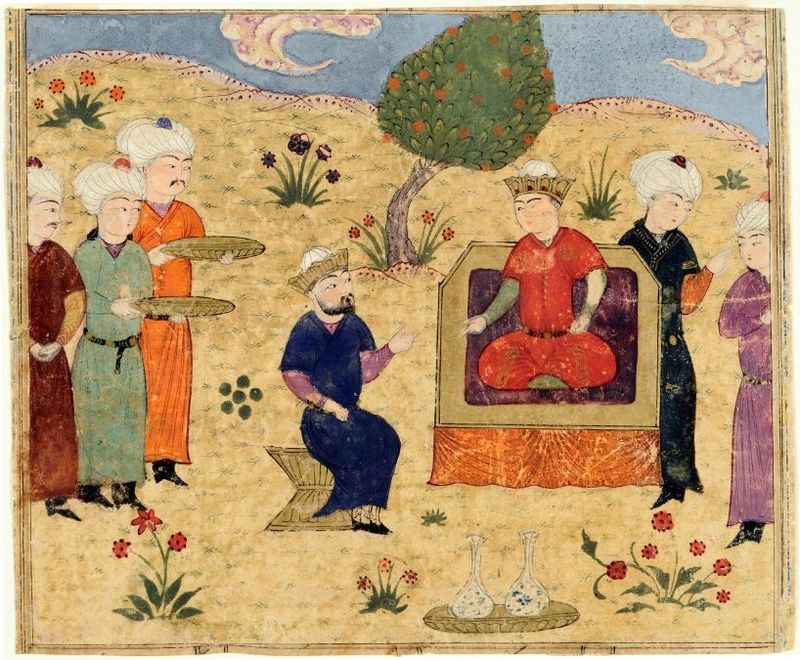
“Kay Kavus crowns his grandson Kay Khusraw”, from the Shahnameh, depicting a carpet from the Ilkhanate period.
In 1463, the Venetian Senate, amidst the Ottoman–Venetian War (1463–1479), initiated diplomatic relations with Uzun Hassan’s court in Tabriz. Giosafat Barbaro, sent to Tabriz in 1473, noted the splendid carpets within the palace, including some area rugs made of silk.
During 1403-05, Ruy González de Clavijo served as the ambassador of Henry III of Castile at Timur’s court, where he observed carpets covering the floors. Timurid period miniatures illustrated carpets featuring geometrical designs, octagons, stars, knot patterns, and Kufic script-inspired design rug borders. Unfortunately, no carpets woven before 1500 AD have survived.
More about: Ilkhanid Dynasty rugs and carpets | Mughal Dynasty carpets and rugs | Timurid Dynasty carpets and rugs
The Safavid Period (1501–1732):
In 1499, Persia witnessed the rise of a new dynasty with Shah Ismail I as its founder, who was related to Uzun Hassan. Shah Ismail I is celebrated as the first national sovereign of Persia following the Arab conquest, and he established Shi’a Islam as Persia’s state religion. Shahs like Tahmasp I and Shah Abbas I subsequently embraced Persian Safavid art. The court manufactories likely originated during Shah Tahmasp’s rule in Tabriz but were definitively established by Shah Abbas when he relocated the capital from Tabriz to Isfahan, central Persia, amid the Ottoman–Safavid War (1603–18). This marked the transformation of carpet weaving from a cottage industry to a revered fine art.
The Safavid era represents a pinnacle in Persian art, including carpet weaving. Carpets from later Safavid periods still exist, showcasing intricate and elaborate designs. The fact that the earliest known carpets exhibit such sophistication implies that the art of carpet weaving must have existed for some time before the magnificent Safavid court carpets were crafted. Since no early Safavid carpets have survived, researchers have focused on Timurid period book illuminations and miniature paintings. These artworks depict colorful carpets with repeating geometric patterns, often arranged in checkerboard-like designs, accompanied by border ornaments reminiscent of Islamic calligraphy.
Notably, these designs bear striking similarities to Anatolian carpets of the same period, including “Holbein carpets,” suggesting a shared design source. Timurid designs might have influenced both Persian and Anatolian carpets during the early Safavid and Ottoman eras.
More about Safavid Dynasty rugs and carpets
The “Design Rug Revolution”:
Towards the late fifteenth century, the designs of carpets depicted in miniatures underwent significant transformation. Large central medallions appeared, accompanied by intricate curvilinear floral patterns. These rug patterns, motifs and designs featured large spirals, floral motifs, and depictions of animals, often mirrored along the carpet’s axes to create harmony and rhythm. The earlier “Kufic” border design gave way to intricate tendrils and arabesques. These complex patterns necessitated more sophisticated weaving techniques, as compared to the simpler rectilinear designs. Additionally, these patterns required collaboration between artists, weavers and a means to communicate the artist’s vision effectively, typically achieved through a design template called a rug cartoon. The technical methods employed by Safavid manufacturers to achieve this complexity remain a mystery. Nonetheless, the outcome of their efforts marked what Kurt Erdmann termed the “carpet design revolution.”
Evidently, these innovative designs initially emerged in miniature paintings, where they appeared on book covers as early as the fifteenth century. This marked the establishment of the “classical” design of Islamic rugs, featuring medallions and corner patterns known as “Lechek Torunj.” In 1522, Ismail I appointed Kamal ud-Din Behzad, a renowned painter of the Herat school, as the director of the royal atelier. Behzad’s influence was pivotal in shaping later Safavid art. Notably, surviving Safavid carpets differ from those depicted in miniature paintings, making it challenging to differentiate, classify, and date period carpets. The same holds true for European paintings, where Persian carpets appeared only after the seventeenth century, in stark contrast to Anatolian carpets.
Exploring Safavid Carpets and Beyond:
The quest to categorize and date Safavid rugs often commences with carpets like the iconic Ardabil carpet, which bear inwoven inscriptions, including dates.
The Inwoven inscription of the Ardabil carpet reads:
“I have no refuge in the world other than thy threshold.
There is no protection for my head other than this door.
The work of the slave of the threshold Maqsud of Kashan in the year 946.”
The year 946 in the Islamic calendar corresponds to AD 1539–1540, pinpointing the creation of the Ardabil carpet to the reign of Shah Tahmasp. He generously donated this carpet to the shrine of Shaykh Safi-ad-din Ardabili in Ardabil, revered as the spiritual progenitor of the Safavid dynasty.
Another inscription graces the “Hunting Carpet,” now housed in the Museo Poldi Pezzoli, Milan Italy, marking its creation in 949 AH / AD 1542–3.
The Inwoven inscription of the Milan Hunting carpet reads:
“By the diligence of Ghyath ud-Din Jami was completed
This renowned work, that appeals to us by its beauty
In the year 949”
During the 17th century, the number of sources for precise dating and attributing provenance increased. Safavid carpets began to be exchanged as diplomatic gifts with European cities and states as diplomatic relations intensified. In 1603, Shah Abbas gifted a carpet adorned with inwoven gold and silver threads to Venetian doge Marino Grimani. European nobles even started commissioning carpets directly from Kashan and Isfahan manufacturers, requesting specific designs, including European coats of arms.
These acquisitions were meticulously documented. For instance, in 1601, Armenian envoy Sefer Muratowicz was dispatched to Kashan by the Polish king Sigismund III Vasa to commission eight carpets featuring the Polish royal court’s arms. The weavers in Kashan completed the task, and on September 12, 1602, Muratowicz presented the carpets to the Polish king, along with the bill. Although initially labeled as “Polish” or “Polonaise” carpets by Western art historians, they were later more aptly termed “Shah Abbas” carpets, thanks to Kurt Erdmann’s suggestion.
The Afsharid (1736–1796) and Zand (1750–1796) Dynasties:
During the Afsharid and Zand dynasties, carpet weaving languished as an insignificant handicraft. These periods saw no significant records of carpet production.
The Qajar Dynasty (1789–1925):
In 1789, Mohammad Khan Qajar ascended to the Persian throne, inaugurating the Qajar dynasty’s rule, which ushered in a period of order and comparative peace in Persia. This era presented an opportunity for the revival of the carpet industry. Three influential Qajar monarchs—Fath-Ali Shah Qajar, Naser al-Din Shah Qajar and Mozaffar ad-Din Shah Qajar – contributed to the resurgence of Persian traditions. Around 1885, weavers in Tabriz spearheaded the modernization of the carpet weaving industry in Persia.
More about the Qajar Dynasty 19th Century Rug Revival
The Pahlavi Dynasty (1925–1979):
Following the Russian Revolution, Persia became a battleground, with Britain using it as a launching point for a failed attack into Russia in 1917. This led to the Soviet Union annexing parts of northern Persia, creating the Persian Soviet Socialist Republic by 1920. The Iranian government, except for its capital, had effectively lost control. In 1925, Reza Shah, supported by Britain, deposed Ahmad Shah Qajar, the last Shah of the Qajar dynasty, establishing the Pahlavi dynasty. Under Reza Shah’s rule, Iran adopted a constitutional monarchy, which persisted until the Iranian Revolution in 1979.
Reza Shah initiated social, economic, and political reforms, modernizing the Iranian state. As part of efforts to stabilize and legitimize their reign, both Reza Shah and his son Mohammad Reza Pahlavi sought to revive ancient Persian traditions. Carpet weaving, often featuring traditional designs, became a significant component of this cultural revival. In 1935, Reza Shah founded the Iran Carpet Company, bringing carpet weaving under government control. Elaborate finely woven carpets, including those with inwoven gold and silver threads, were woven for export and used as diplomatic gifts.
Under Pahlavi rule, the Iranian government aimed to centralize and modernize the nation, consolidating authority over its citizens. Reza Shah’s land reform program in 1962, part of the “White Revolution,” disrupted traditional political structures of nomadic tribes and their way of life. Persian Nomadic carpet weaving, which had already experienced a decline due to more commercials synthetic dyes and standardized patterns and designs in the late 19th century, was nearly eradicated by the policies of the last imperial dynasty in Iran.
The Evolution of Persian Carpets in Modern Times:
Following the Iranian Revolution, there was initially limited information available regarding carpet weaving in Iran. However, in the 1970’s and 1980’s, a newfound interest in Persian Gabbeh rugs emerged in Europe. These types of area rugs, originally woven by nomadic tribes for their personal use, captivated Western consumers with their rustic rug weaving techniques and simple, abstract rug designs.
In 1992, the inaugural Grand Persian Conference and Exhibition held in Tehran showcased modern Persian carpet designs for the first time. Renowned Persian master rug weavers like Razam Arabzadeh presented area rug styles woven using traditional techniques in some of the best rug materials, but featuring unconventional, contemporary designs. Subsequent Grand Conferences have revealed two prominent trends in Iranian carpet weaving today.
On one hand, Iranian manufacturers have been pioneering modern and innovative artistic designs, carrying the ancient design tradition into the twenty-first century. On the other hand, there has been a revival of interest in natural dyes, particularly among commercial enterprises that commission tribal design area rugs and carpets from village weavers. This practice ensures a consistent source of income for these weavers. Typically, companies provide the materials and specify the designs, while still allowing weavers a degree of creative freedom.
However, Persian carpets in today’s market are under US embargo restrictions. This resulted in more competition from other rug making origins and countries with lower labor costs and more cost-effective production methods. Machine-woven rugs and tufted area rugs, as well as more commercial handwoven area rugs using faster and less costly loop weaving techniques, offer rugs with “oriental” designs, though they often lack artistic value. Traditional handmade carpets, crafted from sheep wool dyed with natural colors, are increasingly sought after. These carpets are typically more expensive and sold at higher prices due to the extensive manual labor involved in their production, which has changed little since ancient times. Their artistic designs also contribute to their value. Consequently, Persian carpets and rugs endure as a symbol of luxury, beauty and art, maintaining their esteemed status in the modern era.
Learn more about: What’s So Special About Persian Rugs? | Persian Rug Colors and Their Meanings | What are the most popular Persian rugs? | The Handcrafted Persian Area Rug | Indo Persian Chahar Bagh Gardens and Rugs | Home Decorating With Persian Rugs
This rug blog post about the complete history and timeline of Persian rugs was published by Nazmiyal Rugs


